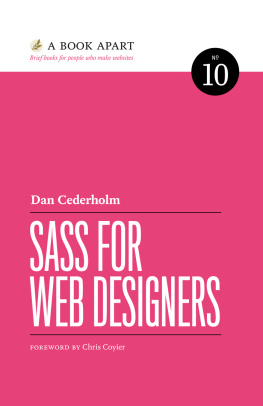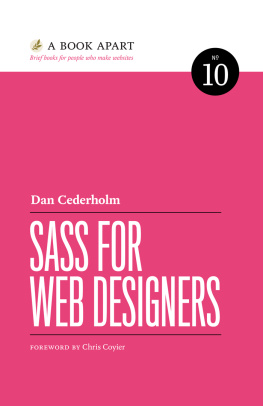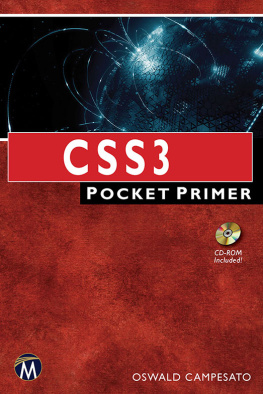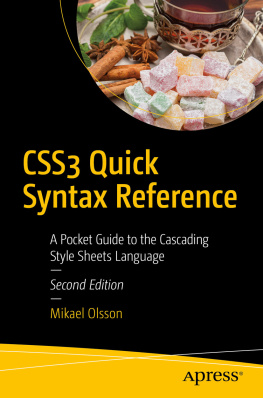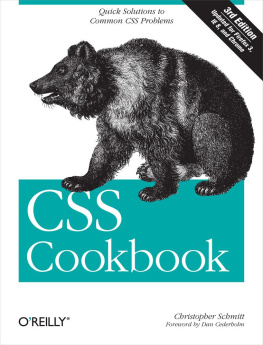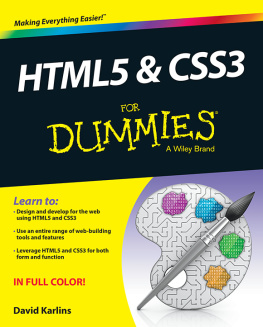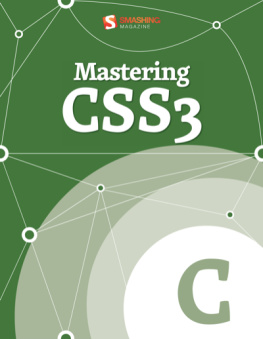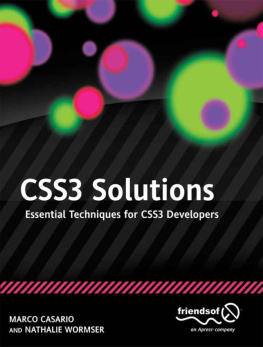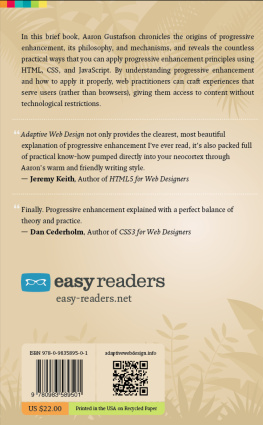Dan Cederholm - CSS3 for Web Designers
Here you can read online Dan Cederholm - CSS3 for Web Designers full text of the book (entire story) in english for free. Download pdf and epub, get meaning, cover and reviews about this ebook. year: 2010, publisher: A Book Apart, genre: Computer. Description of the work, (preface) as well as reviews are available. Best literature library LitArk.com created for fans of good reading and offers a wide selection of genres:
Romance novel
Science fiction
Adventure
Detective
Science
History
Home and family
Prose
Art
Politics
Computer
Non-fiction
Religion
Business
Children
Humor
Choose a favorite category and find really read worthwhile books. Enjoy immersion in the world of imagination, feel the emotions of the characters or learn something new for yourself, make an fascinating discovery.
- Book:CSS3 for Web Designers
- Author:
- Publisher:A Book Apart
- Genre:
- Year:2010
- Rating:3 / 5
- Favourites:Add to favourites
- Your mark:
- 60
- 1
- 2
- 3
- 4
- 5
CSS3 for Web Designers: summary, description and annotation
We offer to read an annotation, description, summary or preface (depends on what the author of the book "CSS3 for Web Designers" wrote himself). If you haven't found the necessary information about the book — write in the comments, we will try to find it.
CSS3 for Web Designers — read online for free the complete book (whole text) full work
Below is the text of the book, divided by pages. System saving the place of the last page read, allows you to conveniently read the book "CSS3 for Web Designers" online for free, without having to search again every time where you left off. Put a bookmark, and you can go to the page where you finished reading at any time.
Font size:
Interval:
Bookmark:
Copyright 2010 by Dan Cederholm
All rights reserved
Publisher: Jeffrey Zeldman
Designer: Jason Santa Maria
Editor: Mandy Brown
Technical Editor: Ethan Marcotte
Copyeditor: Krista Stevens
ISBN 978-0-9844425-3-9
A Book Apart
New York, New York
http://books.alistapart.com
Websites are not the same as pictures of websites. When one person designs in Photoshop and another converts the design to markup and CSS, the coder must make guesses and assumptions about what the designer intended. This interpretive process is never without frictionunless the coder is Dan Cederholm. When Dan codes other peoples designs, he gets everything right, including the parts the designer got wrong. For instance, Dan inevitably translates a designers fixed Photoshop dimensions into code that is flexible, accessible, and bulletproof. (Indeed, Dan coined the phrase bulletproof web design while teaching the rest of us how to do it.)
In Dans case, flexible never means sloppy. The details always matter. Thats because Dan is not only a brilliant front-end developer and user advocate, he is also a designer to his core. He dreams design, bleeds design, and even gave the world a new way to share design at dribbble.com. Dan is also a born teacher and funny guy whose deadpan delivery makes Steven Wright look giddy by comparison. Dan speaks all over, helping designers improve their craft, and he not only educates, he kills.
And that, my friends, is why weve asked him to be our (and your) guide to CSS3. You couldnt ask for a smarter, more experienced, more design-focused guide or a bigger web standards geek than our man Dan. Enjoy the trip!
Jeffrey Zeldman
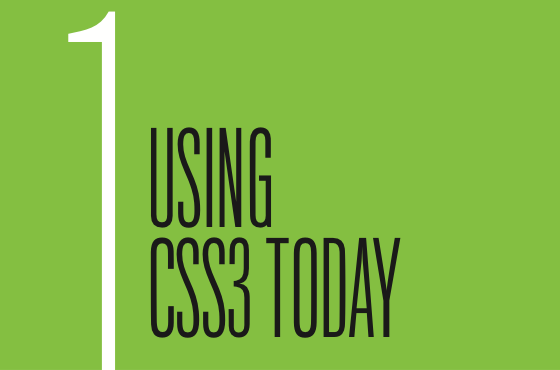
Looking back upon the storied history of CSS , we see some important milestones that have shaped our direction as web designers. These watershed techniques, articles, and events helped us create flexible, accessible websites that we could be proud of both visually as well as under the hood.
You could argue that things began to get interesting back in 2001, when Jeffrey Zeldman wrote To Hell With Bad Browsers ( signaling the dawn of the CSS Age. This manifesto encouraged designers to push forward and use CSS for more than just link colors and fonts, leaving behind older, incapable browsers that choked on CSS1. Yes, CSS1.
We spent the next several years discovering and sharing techniques for using CSS to achieve what we wanted for our clients and bosses. It was an exciting time to be experimenting, pushing boundaries, and figuring out complex ways of handling cross-browser rendering issuesall in the name of increased flexibility, improved accessibility, and reduced code.
Somewhere around 2006 or so, the talk about CSS went quiet. Most of the problems we needed to solve had documented solutions. Common browser bugs had multiple workarounds. We created support groups for designers emotionally scarred by inexplicable Internet Explorer bugs. Our hair started to gray. (OK, Im speaking for myself here.) Most importantly though, the contemporary crop of browsers was relatively stagnant. This period of status quo gave us time to craft reusable approaches and establish best practices, but things got a little, dare I say, boring for the CSS aficionado yearning for better tools.
Thankfully things changed. Browsers began iterating and updating more rapidly (well, some of them anyway). Firefox and Safari not only started to gain market share, they also thrived on a quicker development cycle, adding solid standards support alongside more experimental properties. In many cases, the technologies that these forward-thinking browsers chose to implement were then folded back into draft specifications. In other words, periodically it was the browser vendors that pushed the spec along.
Ask a roomful of web designers, Who likes reading specs? and you might get one person to raise their hand. (If you are that person, I commend you and the free time you apparently have). Although they serve as important references, I certainly dont enjoy reading specifications in their entirety, nor do I recommend doing so in order to grasp CSS3 as a whole.
The good news is that CSS3 is actually a series of modules that are designed to be implemented separately and independently from each other. This is a very good thing. This segmented approach has enabled portions of the spec to move faster (or slower) than others, and has encouraged browser vendors to implement the pieces that are further along before the entirety of CSS3 is considered finished.
The W3C explains the module approach:
Rather than attempting to shove dozens of updates into a single monolithic specification, it will be much easier and more efficient to be able to update individual pieces of the specification. Modules will enable CSS to be updated in a more timely and precise fashion, thus allowing for a more flexible and timely evolution of the specification as a whole.
The benefit here for us web designers is that along with experimentation and faster release cycle comes the ability to use many CSS3 properties before waiting until they become Candidate Recommendations, perhaps years from now.
Now, by all means, if you enjoy reading specifications, go for it! Naturally theres a lot to be learned in therebut its far more practical to focus on whats currently implemented and usable today, and those are the bits that well be talking about in the rest of this chapter. Later, well apply those bits in examples throughout the rest of the book.
Ive always learned more about web design by dissecting examples in the wild rather than reading white papers, and thats what well stress in the pages that follow.
Ive been hearing this quite a bit from fellow web designers across the globe: I cant wait to use CSS3 when its done.
But the truth is everyone can begin using CSS3 right now. And fortunately you dont have to think differently or make drastic changes to the way you craft websites in order to do so. How can anyone use CSS3 on any project? Because were going to carefully choose the situations where we apply CSS3, focusing squarely on the experience layer.
If weve been doing things right over the past several years, weve been building upon a foundation of web standards (semantic HTML and CSS for layout, type, color, etc.), leaving much of the interaction effectsanimation, feedback, and movementto technologies like Flash and JavaScript. With CSS3 properties being slowly, but steadily introduced in forward-thinking browsers, we can start to shift some of that experience layer to our stylesheets.
As an interface designer who leans heavily toward the visual side of design rather than the programmatic side, the more I can do to make a compelling user experience using already-familiar tools like HTML and CSS, the more I do a happy little dance.
CSS3 is for web designers like you and I, and we can start using portions of it today, so long as we know when and how to fold it in.
In terms of a websites visual experience, we could group things into two categories: critical and non-critical ( TABLE 1.01 ).
TABLE 1.01 : A websites visual experience can be grouped into critical and non-critical categories. The latter are where CSS3 can be applied today.| Critical | Non-critical |
|---|---|
| Branding |
Font size:
Interval:
Bookmark:
Similar books «CSS3 for Web Designers»
Look at similar books to CSS3 for Web Designers. We have selected literature similar in name and meaning in the hope of providing readers with more options to find new, interesting, not yet read works.
Discussion, reviews of the book CSS3 for Web Designers and just readers' own opinions. Leave your comments, write what you think about the work, its meaning or the main characters. Specify what exactly you liked and what you didn't like, and why you think so.


